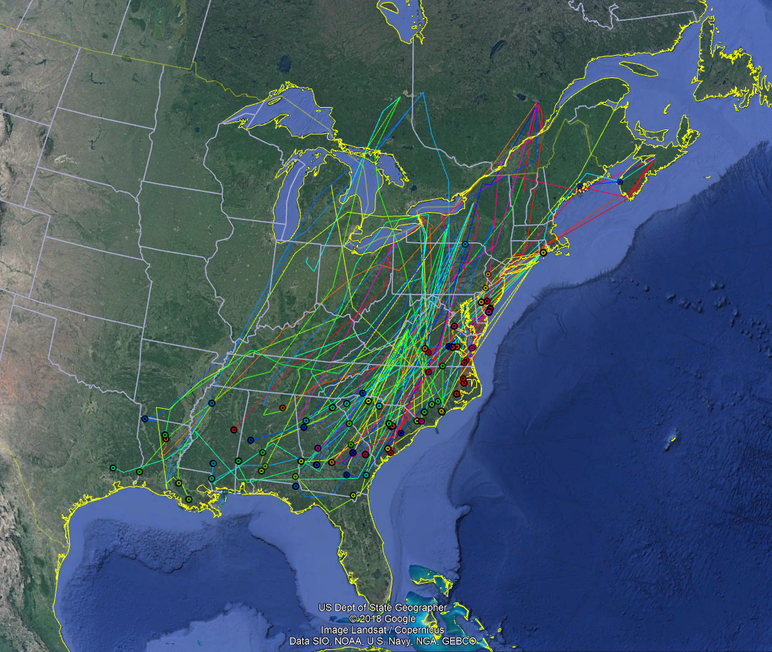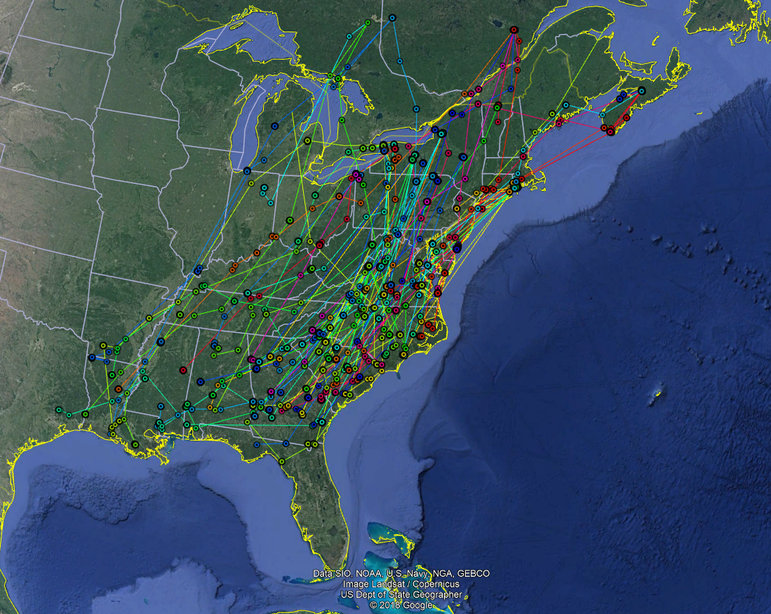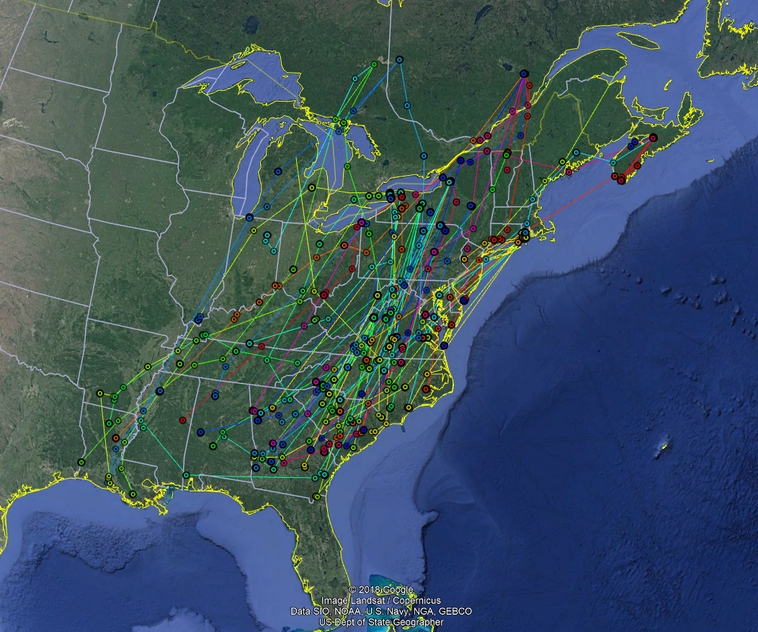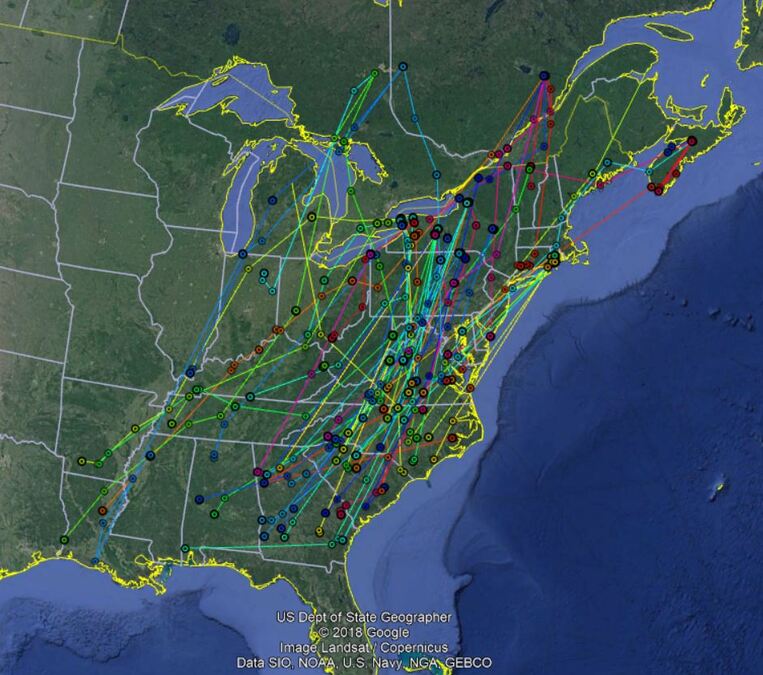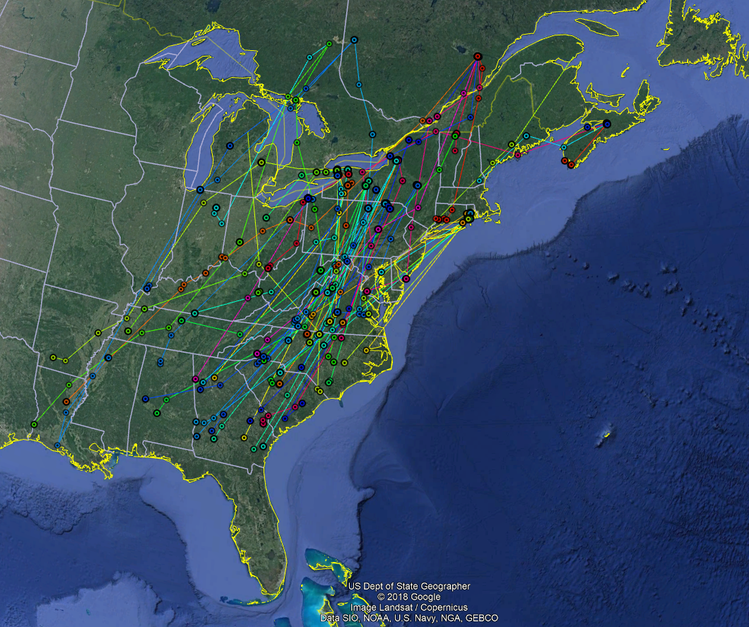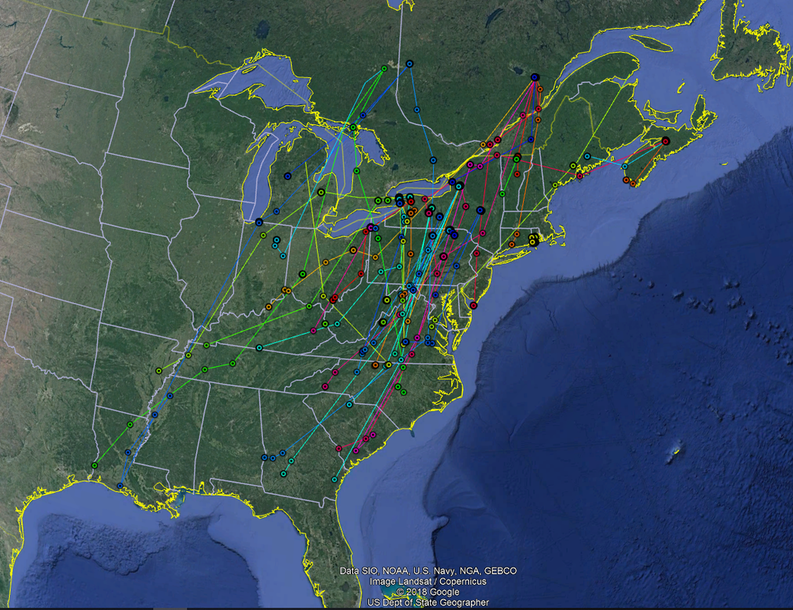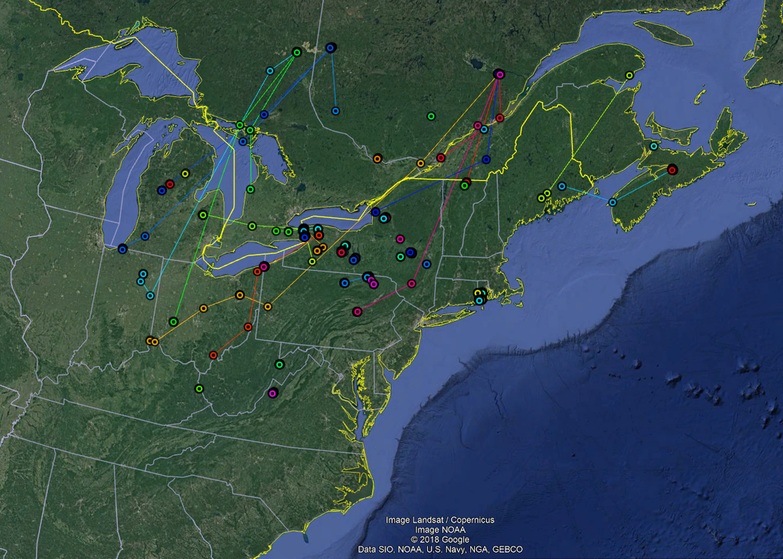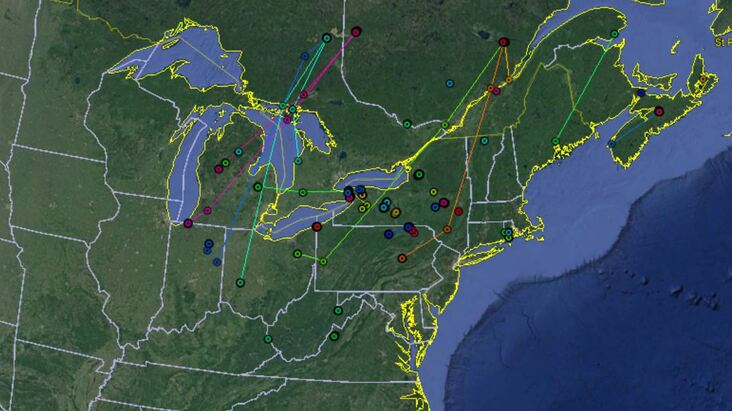Update 30 December 2019: We received a number of data uploads this past weekend but most birds have remained stationary. One woodcock that recently migrated from Nova Scotia into Maine has continued moving south and is currently in New Jersey. We have also received data from two woodcock still in Pennsylvania and three still in Rhode Island. Absolutely fascinating. Locations (points) shown are from the last week, with polylines showing previous fall movements.
Update 27 December 2019: Very little migratory movement observed over the Christmas holiday. A few woodcock moved south primarily in the mid-Atlantic region and one bird crossed the Bay of Fundy from Nova Scotia into Maine. Locations (points) shown are from the last week, with polylines showing previous fall movements.
Update 23 December 2019: A few woodcock are continuing to migrate south, with most migrating birds being captured at stopover sites (e.g., New Jersey). However, some woodcock are still near pre-migratory sites in Rhode Island.
Woodcock locations depicted in the map above are from the past seven days. Note that most birds are in Louisiana, Mississippi, Alabama, Georgia, and South Carolina with additional birds along the Atlantic Coast (North Carolina, Virginia, New Jersey, and Maryland).
Woodcock locations depicted in the map above are from the past seven days. Note that most birds are in Louisiana, Mississippi, Alabama, Georgia, and South Carolina with additional birds along the Atlantic Coast (North Carolina, Virginia, New Jersey, and Maryland).
Update 20 December 2019: A few woodcock are still continuing to move further south, but most birds appear to have reached their wintering site. The most recent cold weather snap is expected to push some birds further south, but we will need to wait a few days for birds to upload locations.
Update 16 December 2019: Migration is continuing to slow down throughout most of the mid-continental United States, however some woodcock are still trickling south. There are more woodcock moving south along the Atlantic coast, possibly due to moderated weather along the coast from the Atlantic ocean.
Most notable movements from this past week were the 2 woodcock staging in southern Nova Scotia crossed the Bay of Fundy and Gulf and Maine, arriving in Maine and Massachusetts respectively. Additionally, one of two woodcock still at capture locations in Pennsylvania have initiated migration and there are still at least two woodcock near capture sites in Rhode Island.
A woodcock initially marked in New York has migrated into eastern Texas, just northeast of Houston. Interestingly, she migrated south from New York to coastal Georgia, before flying west to Texas. This is the first record of a bird in our study entering Texas, so we are pretty excited!
Most notable movements from this past week were the 2 woodcock staging in southern Nova Scotia crossed the Bay of Fundy and Gulf and Maine, arriving in Maine and Massachusetts respectively. Additionally, one of two woodcock still at capture locations in Pennsylvania have initiated migration and there are still at least two woodcock near capture sites in Rhode Island.
A woodcock initially marked in New York has migrated into eastern Texas, just northeast of Houston. Interestingly, she migrated south from New York to coastal Georgia, before flying west to Texas. This is the first record of a bird in our study entering Texas, so we are pretty excited!
Update 9 December 2019: The post thanksgiving snow storm that blanketed most of New England in snow caused some woodcock to migrate further south, but some birds are choosing to remain on the snow periphery. At least one woodcock is still in Rhode Island, northwestern Pennsylvania, at least two are still on Nova Scotia! While the majority of these birds are juveniles, there is at least one adult as well.
More woodcock are migrating into South Carolina and Georgia. And there have even been a few strange migrations observed, in which reach south-Atlantic states and then 'j-hook' west to the Gulf Coast states. While only a small number of individuals display this behavior, we have observed it both fall 2018 and 2019.
Crews in New Jersey captured more than 30 woodcock in two nights and deployed 15 transmitters, Nice Job! Crews in Maryland are planning to attempt captures Monday (12/9) and Tuesday (12/10). There should be plenty of birds on the Delmarva peninsula and we are wishing them the best of luck.
More woodcock are migrating into South Carolina and Georgia. And there have even been a few strange migrations observed, in which reach south-Atlantic states and then 'j-hook' west to the Gulf Coast states. While only a small number of individuals display this behavior, we have observed it both fall 2018 and 2019.
Crews in New Jersey captured more than 30 woodcock in two nights and deployed 15 transmitters, Nice Job! Crews in Maryland are planning to attempt captures Monday (12/9) and Tuesday (12/10). There should be plenty of birds on the Delmarva peninsula and we are wishing them the best of luck.
Update 1 December 2019: Very few woodcock have migrated in the past week. Winter storms are predicted to hit most of New England and parts of the mid-Atlantic in the next few days and we expect some of the woodcock in Pennsylvania and Rhode Island to migrate south. Stay tuned!
Update 25 November 2019: Migration is still progressing, with a small number of birds continuing to fly south every few days. However, following large migratory movements 1-2 weeks ago, a large portion of birds have arrived on the wintering grounds and have likely terminated migration.
An increasing proportion of woodcock in Rhode Island, Virginia, and West Virginia have been initiating migration, yet some birds are still near their initial capturing locations. Interestingly, two woodcock are still at their initial capture locations in Northwestern and Northeastern Pennsylvania.
All Woodcock marked in Nova Scotia this fall have initiated migration, but only three have crossed the Gulf of Maine or Bay of Fundy. One Woodcock recently initiated migration from southern Nova Scotia and flew 750 km (466 mi) in a single night to Staten Island, presumably crossing the Gulf of Maine.
An increasing proportion of woodcock in Rhode Island, Virginia, and West Virginia have been initiating migration, yet some birds are still near their initial capturing locations. Interestingly, two woodcock are still at their initial capture locations in Northwestern and Northeastern Pennsylvania.
All Woodcock marked in Nova Scotia this fall have initiated migration, but only three have crossed the Gulf of Maine or Bay of Fundy. One Woodcock recently initiated migration from southern Nova Scotia and flew 750 km (466 mi) in a single night to Staten Island, presumably crossing the Gulf of Maine.
Update 22 November 2019: Woodcock are continuing to arrive on the wintering grounds, with large numbers of birds in Georgia, South Carolina, North Carolina, and Virginia. Large numbers of birds have been initiating migration from Rhode Island.
Update 18 November 2019: Large numbers of woodcock are Virginia, North Carolina, South Carolina, Tennessee, and Kentucky. More woodcock are continually arriving in Georgia, Alabama, Mississippi and Louisiana. Recent winter storms have covered much of norther New England and southern Canada in Snow, forcing the few remaining woodcock south. The first few birds in Rhode Island and West Virginia have initiated migration, but most birds are remaining near their capture sites.
Woodcock marked in Nova Scotia are for the most part still in the province, with only 2 of 6 birds crossing the Bay of Fundy or Gulf of Maine. The remaining birds are either still at the capture site or at stopover sites still on the province. When the woodcock leave (if they do) they will encounter an increasingly snow covered Maine and northern New England.
We recently documented the longest single night migration for the project. A juvenile male flew ~1,000 kilometers or 630 miles in a single flight! And even after that long-distant flight, he made smaller migration journeys the following three nights!
Woodcock marked in Nova Scotia are for the most part still in the province, with only 2 of 6 birds crossing the Bay of Fundy or Gulf of Maine. The remaining birds are either still at the capture site or at stopover sites still on the province. When the woodcock leave (if they do) they will encounter an increasingly snow covered Maine and northern New England.
We recently documented the longest single night migration for the project. A juvenile male flew ~1,000 kilometers or 630 miles in a single flight! And even after that long-distant flight, he made smaller migration journeys the following three nights!
Update 12 November 2019: Large numbers of woodcock are departing from New England and southern Canada. The majority of woodcock in New York have initiated migration and large numbers of migrants are in Pennsylvania, Virginia, and North Carolina. Woodcock have begun reaching their wintering grounds along states bordering the southern Atlantic and Gulf of Mexico.
We have increasingly observed woodcock migrating from Nova Scotia across the Gulf of Maine, however 2 birds are still near the capture site as of 11/12/2019. We are interested to see how long the woodcock remain before migrating south!
We still have not observed any migration initiations from woodcock in Rhode Island, West Virginia, or Virginia, despite large number of birds moving through those states.
We have increasingly observed woodcock migrating from Nova Scotia across the Gulf of Maine, however 2 birds are still near the capture site as of 11/12/2019. We are interested to see how long the woodcock remain before migrating south!
We still have not observed any migration initiations from woodcock in Rhode Island, West Virginia, or Virginia, despite large number of birds moving through those states.
Update 07 November 2019: Most woodcock have left Ontario and Quebec, however we do still have one marked bird in Eastern Quebec that has yet to initiate migration. A second woodcock has left Nova Scotia and appears to have crossed the Gulf of Maine. More woodcock in New York are starting to initiate migration but no marked birds from Pennsylvania, Rhode Island, Virginia, or West Virginia have.
A handful of woodcock have arrived in North Carolina and Virginia. We do not know if birds are just stopping over or if they are in the process of establishing winter residencies.
A handful of woodcock have arrived in North Carolina and Virginia. We do not know if birds are just stopping over or if they are in the process of establishing winter residencies.
Update 04 November 2019: Woodcock are continuing to migrate from Canada into southern Canada, northern New England, and the Great Lake States. All but two woodcock have initiated migration in Quebec and Ontario and only one of six has initiated migration in Nova Scotia. We observed one woodcock migrating from Southern Nova Scotia across the Gulf of Maine and he is currently in east central Maine.
Few woodcock marked in New England have initiated migration. One woodcock left western New York and is currently in southern Ohio, but few other birds have initiated migration. Cooler weather is moving into New England later this week and we will have to wait and see how birds respond.
Capture crews in Virginia and West Virginia have deployed 16 transmitters in the past two weeks. We are excited to see where these woodcock migrate to and how long migration takes. Stay tuned.
Few woodcock marked in New England have initiated migration. One woodcock left western New York and is currently in southern Ohio, but few other birds have initiated migration. Cooler weather is moving into New England later this week and we will have to wait and see how birds respond.
Capture crews in Virginia and West Virginia have deployed 16 transmitters in the past two weeks. We are excited to see where these woodcock migrate to and how long migration takes. Stay tuned.
Update 31 October 2019: The only new migratory movements documented were birds leaving eastern Quebec. All other marked woodcock have remained at stopover locations or near their capture sites.
Update 27 October 2019: A few birds more birds from eastern Quebec and Nova Scotia have initiated migratory movements in the last few days, but a number of birds remain in these areas as well, so we expect continued movements of birds out of eastern Canada over the coming days/weeks.
Southern migration by resident woodcock in the northeastern U.S. have been minimal, so right now there are likely large numbers of both migrant and resident woodcock present in northern states.
Southern migration by resident woodcock in the northeastern U.S. have been minimal, so right now there are likely large numbers of both migrant and resident woodcock present in northern states.
Update 24 October 2019: Our most recent uploads have confirmed additional birds moving out of Ontario and Quebec on the heels of the major weather system that moved through eastern North America on October 18th. However some marked birds remained in northern areas of Quebec as recently as October 23rd, so we expect further migration events as more birds move into southern Canada and lake states like Michigan, Indiana, Ohio, New York, and Pennsylvania.
So far, southern migration by resident woodcock in the northeastern U.S. have been minimal, and birds marked in Nova Scotia are likewise staying put.
So far, southern migration by resident woodcock in the northeastern U.S. have been minimal, and birds marked in Nova Scotia are likewise staying put.
Update 22 October 2019: Woodcock on the norther range extent have started migrating. All birds from eastern Ontario and a sub-sample of woodcock from sites in eastern and western Quebec have initiated migration. Most birds that crossed the Great Lakes, stopped over on off-shore islands immediately before crossing the lakes.
We've also observed one bird from western New York move 200 miles directly west into Michigan.
Migration seems to be primarily occurring in Canada, however some shorter distance movements have been observed in both New York and Pennsylvania.
We've also observed one bird from western New York move 200 miles directly west into Michigan.
Migration seems to be primarily occurring in Canada, however some shorter distance movements have been observed in both New York and Pennsylvania.
Spring migration during 2019 was fascinating to watch. Of interest and excitement to us, a number of our woodcock marked in the southeast and mid-Atlantic last winter used westerly migration routes, which is relatively uncommon in the literature. Notice the fan-shaped migration coming out of southeastern South Carolina. Another woodcock marked on the eastern shore of Maryland migrated west, across two of the great lakes and is currently in Wisconsin. All locations on the map below were collected during spring migration of 2019. Scroll further down for additional maps from Fall 2018 and from our pilot field season in Fall 2017, and for some examples of interesting woodcock behavior that represent the types of data we will use to address our project research objectives.
Copyright © 2024 Eastern Woodcock Migration Research Cooperative.
All Rights Reserved.
All Rights Reserved.

